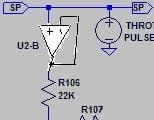Lots to comment on…
Alan B:
I am unsure how to employ this device; certainly it appears to have a lot of value, though I don’t know where it would plug in as the examples of use are numerous. Perhaps with a bit of your help I could understand and learn? :?
 Njay
Njay:
With
R12 between U2-A OUT/UV and GND, I did note that as Throttle rises, Current through R12 drops about 1mA – from about 2.8mA to 1.8mA, and that UV changes range from 3.388-2.255 (w/o) to 3.338-2.256 (with); it was tiresome to reign it back in as R104 went from 2.5K to 2.31K & R107 from 2.6K to 2.89K. <
phooey>. But the real problem is that R12
is not 1.2K, not on my boards cos I’ve already modified them for high-regen-braking -> it’s something like 835 or 935 ohms depending on which of my two controllers were talking about. (It’s at this point I begin ripping my hair out like Larry-Stooge and barking around in a circle on the floor like Curly). What I’m trying to say is that R12 is all relative. Why don’t we just replace it with a nice high-turn 2K POT and have a beer? :wink:
U2: Sorry for being dense, but I need you to explain it to me in terms of
U2-A and
U2-B because I can’t follow it. Or write over the image with the proposed correction, or reference a previous schematic where we may have had it drawn correctly
 Switching devices from 5 to +12V
Switching devices from 5 to +12V: R104 will have to become a 10K POT as it falls right in between stock values for R106 (which was 14K & now 62K), and R101 went from 300 ohms to 1K. All good.
Vcc_L & Diode: Ha! I can do that now right after the keyswitch. My only sad thought was that both controllers would have the same 12-volt supply, but I will try this solution and see if it solves the problem. The C2 cap on my modified controllers is 100V 100uf. There’s not much room to stuff a bigger one, however for my DC-DC converter I placed a retired 63V 470uf cap on the +12V line which is why the voltage barely dips 0.05V when the Left-Right indicators are flashing.

(It always cracked me up to watch the ampmeter on a car dashboard walk left-right when the flashers were going on/off while sitting at a stoplight, poor ol’ alternator struggling at idle to keep up with those lossy incandescent lamps… what’s with that?)
I’d show you
Version 12, but it only has the changes discussed above which ain’t much. Gimme a proper U2 layout like you spoke of and I’ll do it pronto <nods>.
Cheerios or Fruit-Loops for breakfast?
No, make it Cap'n Crunch's Crunch Berries,
KF :wink:
<gosh no wonder I went to the dentist so often…>










